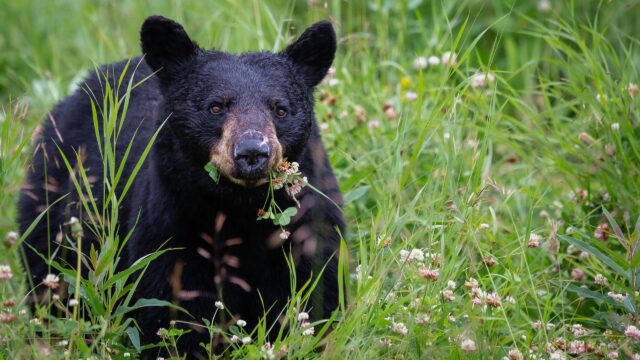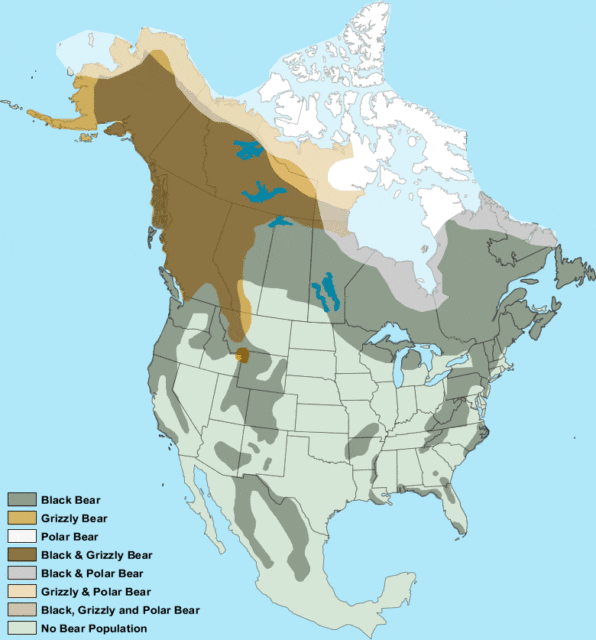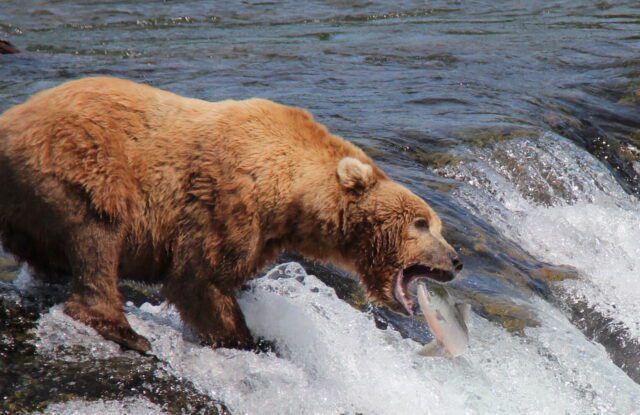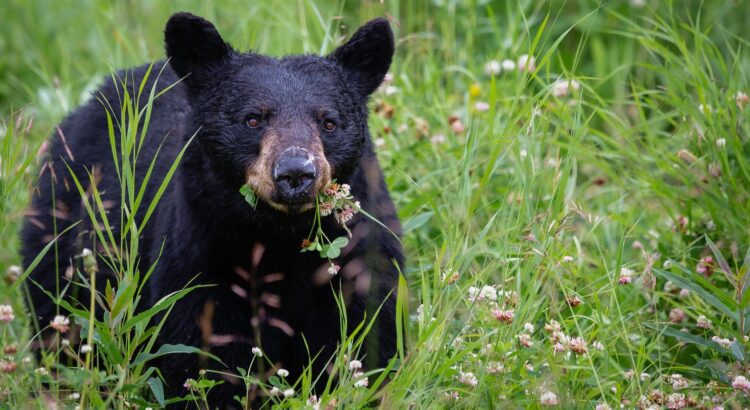by Anna Beaudette, SCA Interpretive Ranger at Franconia Notch State Park
Have you ever seen a bear before and struggled to identify it? Learn all about the traits of different bear species to figure out what you saw or what you might be likely to see in your given area!
Black bears, brown bears, and polar bears are the only three species of bears that are found in North America. The only type of bear found in New Hampshire is the American black bear. These three types of bears can have very different appearances, behavior, and ranges. First, we’ll start with our local furry friend, black bears!
Black Bears

Black bears (Ursus americanus) are smaller than polar bears and brown bears. When on all fours, they can reach a height of two or three feet and range anywhere from 50 to 80 inches long (nose to tail). The American black bear exhibits sexual dimorphism, which is when there are prominent differences in traits between males and females of the same species. For example, male black bears are much larger (200-250 lbs.), and therefore heavier, than female black bears (125-150 lbs.). Black bears are found through much of Canada, the Sierras, Idaho, Montana, the Rocky Mountains, the Great Lakes area, Florida, the Appalachian Mountains, and New England.
Black bears do not “hibernate” so to speak, but rather, they enter a deep winter’s sleep that they can be woken up from. During this period of dormancy, their heart rate drops 50-60% and they lose a quarter of their body weight. Their dens can be found in brush piles, in a tree hollow, or underneath fallen trees. Black bears typically eat lots of berries, seeds, nuts, grasses, and insects. However, when presented with the opportunity, black bears will seek out food from trashcans and bird feeders. It’s important to properly stow away food or trash to prevent conflict with black bears. If you have a bird feeder, consider taking it down from April to December to avoid habituating wild bears.

Black Bear Breakdown:
- Female weight (avg.): 125-150 lbs.
- Male weight (avg.): 200-250 lbs.
- Diet: Berries, fruits, roots, blossoms, insects, nuts (beechnut, acorns, etc.), termites, honey, fish
- Habitat: Forested areas with thick brush/vegetation, wetlands + near rivers
- Population size (U.S.): Approx. 339,000-465,000 individuals
- Population size (NH): 5,600 individuals
- Lifespan: Up to 20 years (in the wild)
Brown Bears

Brown bears (Ursus arctos) include the following subspecies found in North America: grizzly bears, Kodiak brown bears, and the Alaska Peninsula brown bear. Brown bears are omnivorous, meaning that they eat a wide range of plants and animals. Their diet primarily consists of plants, berries, fish, and small mammals. These bears have a noticeable shoulder hump that distinguishes them from other bear species. They have long, strong claws that help them dig and catch their food. The diet, size, and adaptations of these bears vary a lot given their specific location.
Similar to other bear species, brown bears are dormant during the winter, resulting in a low body temperature and low heart rate. Brown bears emerge from their dens around April and return in the Fall. Female brown bears begin mating after they are four to six years old. While some male brown bears can reach 860 lbs., Kodiak bears can weigh up to 1,500 lbs.
Brown Bear Breakdown:
- Female weight (avg.): 200-450 lbs.
- Male weight (avg.): 300-860 lbs.
- Diet: Plants, berries, fish, and small mammals
- Habitat: Forests, mountains, and tundra
- Population size (U.S.): Approx. 40,000-55,000 individuals
- Lifespan: 20-30 years (in the wild)
Polar Bears

In the U.S., polar bears (Ursus maritimus) are only found in Alaska. They typically live around 25 years in the wild and are considered the largest bear species in the world. These bears have black skin to absorb the heat and insulate their bodies from the cold tundra climate. Their thick white coats help them camouflage as well as repel water. Polar bears are amazing swimmers that have webbed paws, which make them more aquatically adapted than other bear species. These bears eat significantly more meat and fats than other bear species, as food resources are limited in cold, barren climates. Polar bears reside at the top of the food chain; therefore, they have few predators, aside from male polar bears that often target cubs.
- Female weight (avg.): 330-680 lbs.
- Male weight (avg.): 660-1760 lbs.
- Diet: Seals, whale carcasses, birds, fish, terrestrial mammals, berries
- Habitat: Arctic sea ice (Alaska)
- Population size (U.S.): 4,000-7,000 individuals
- Lifespan: Up to 25 years (in the wild)
Fun Facts
- Black bears are solitary animals
- They tend to be nocturnal in areas with more humans
- Adult male black bears have a larger range (120 square miles), of territory than females (10 square miles)
- Bears enter of phase of hyperphagia before hibernation where they gain hundreds of pounds to build fat storage
Sources
Apex predator and ecosystem protector: 10 grizzly bear facts – WWF.CA
Black Bear | State of New Hampshire Fish and Game
Types of Bears – Bears (U.S. National Park Service)
Black Bear Fact Sheet | Blog | Nature | PBS
Brown Bear Population by Country – 2025 Biodiversity Data
Black Bear Population by State (Current Estimates) – Wildlife Informer

